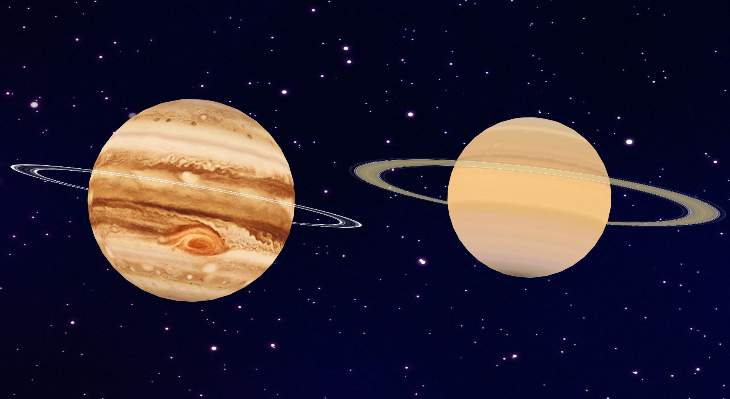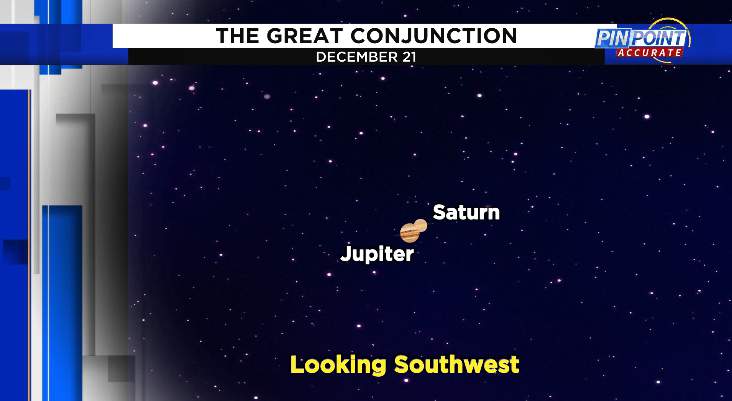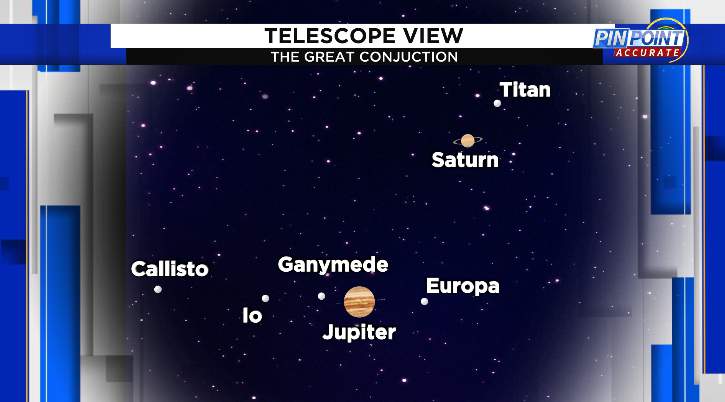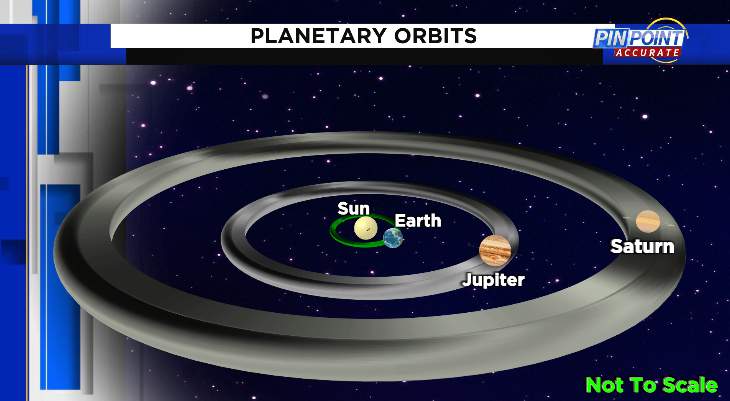‘Christmas Star’: Jupiter, Saturn combine
for rare Great Conjunction
from ClickOrlando.com
by Jonathan Kegges, Meteorologist
(Click on a photo in the following article to see a larger version.)
see also This 12/21/20 article from the Tallahassee Democrat
 ORLANDO, Fla. – It’s a celestial event hundreds of years in the making. Conjunctions are common, occurring when any objects from our perspective get close to each other in space. The Great Conjunction is rare.
ORLANDO, Fla. – It’s a celestial event hundreds of years in the making. Conjunctions are common, occurring when any objects from our perspective get close to each other in space. The Great Conjunction is rare.
 The Great Conjunction happens when Jupiter and Saturn get very close to each from our perspective. Not every Great Conjunction, however, is created equal and that’s what makes the one occurring on the winter solstice so rare and special.
“Each Great Conjunction has different angular separations, or the distances between the two planets can vary by a bit depending on how everything is lined up,” said Seth Mayo, curator of astronomy at the Museum of Arts and Sciences in Daytona Beach.
The last time the two planets were this close to each other, from Earth’s point of view, was back in 1623. “The problem for this Great Conjunction is that it occurred very near sunset, so the Sun’s glare most likely obscured the pair of planets,” Mayo said. “The last observable time these planets were this close was the year 1226.”
Because the planets will be so close together near Christmas, it’s being dubbed the “Christmas Star” by some.
On Dec 21, the two gas giants will be separated by only .1 degree. To the naked eye it will likely appear as two distinguishable separate points, rather than one “star”, but it does depend on ones eyesight and atmospheric conditions. If you have a telescope, the two planets will show up in the same field of view.
The Great Conjunction happens when Jupiter and Saturn get very close to each from our perspective. Not every Great Conjunction, however, is created equal and that’s what makes the one occurring on the winter solstice so rare and special.
“Each Great Conjunction has different angular separations, or the distances between the two planets can vary by a bit depending on how everything is lined up,” said Seth Mayo, curator of astronomy at the Museum of Arts and Sciences in Daytona Beach.
The last time the two planets were this close to each other, from Earth’s point of view, was back in 1623. “The problem for this Great Conjunction is that it occurred very near sunset, so the Sun’s glare most likely obscured the pair of planets,” Mayo said. “The last observable time these planets were this close was the year 1226.”
Because the planets will be so close together near Christmas, it’s being dubbed the “Christmas Star” by some.
On Dec 21, the two gas giants will be separated by only .1 degree. To the naked eye it will likely appear as two distinguishable separate points, rather than one “star”, but it does depend on ones eyesight and atmospheric conditions. If you have a telescope, the two planets will show up in the same field of view.
 Jupiter's moons Callisto, Io, Europa and Ganymede along with Saturn's largest moon Titan will be visible with a telescope. Also in that field of view will reside the biggest moons of the two bodies. A telescope or binoculars will be needed to see the moons.
Beyond Dec 21, Jupiter and Saturn will begin to move away from each other. This trend will continue for the next ten years before the two giants start to move closer together again during the 2030s. This will set up the next Great Conjunction in 2040, although that one will not be as brilliant as 2020's.
The planets won’t be this close again until 2080. In extremely rare fashion, Jupiter completely covers Saturn. That won’t happen again until 7541.
Jupiter's moons Callisto, Io, Europa and Ganymede along with Saturn's largest moon Titan will be visible with a telescope. Also in that field of view will reside the biggest moons of the two bodies. A telescope or binoculars will be needed to see the moons.
Beyond Dec 21, Jupiter and Saturn will begin to move away from each other. This trend will continue for the next ten years before the two giants start to move closer together again during the 2030s. This will set up the next Great Conjunction in 2040, although that one will not be as brilliant as 2020's.
The planets won’t be this close again until 2080. In extremely rare fashion, Jupiter completely covers Saturn. That won’t happen again until 7541.
 Saturn takes about 30 Earth years to make a trip around the sun. It takes Jupiter about 12 Earth years to do the same. In reality, Jupiter and Saturn are extremely far apart, but appear close together from Earth's point of view. Mars was intentionally left out of the diagram, but has an orbit between Earth and Jupiter.
The Great Conjunction occurs because Jupiter has the inside track while orbiting the Sun in our solar system. Since Jupiter’s orbit is smaller than Saturn’s, Jupiter moves around the sun faster and catches up to the Ringed Planet. Think of it as NASCAR race with the infield being the Sun. The car that has the inside lane gets around the infield faster than a car on the outside.
“On very rare occasions, these great conjunctions between Jupiter and Saturn can occur multiple times in year, known as triple conjunctions, due to Earth overtaking these planets with its much faster orbit.” Mayo said. “That won’t happen again until the 2238-2239 time frame, so we have some waiting to do.”
The last time there was a triple conjunction was 1981.
How To See:
Saturn takes about 30 Earth years to make a trip around the sun. It takes Jupiter about 12 Earth years to do the same. In reality, Jupiter and Saturn are extremely far apart, but appear close together from Earth's point of view. Mars was intentionally left out of the diagram, but has an orbit between Earth and Jupiter.
The Great Conjunction occurs because Jupiter has the inside track while orbiting the Sun in our solar system. Since Jupiter’s orbit is smaller than Saturn’s, Jupiter moves around the sun faster and catches up to the Ringed Planet. Think of it as NASCAR race with the infield being the Sun. The car that has the inside lane gets around the infield faster than a car on the outside.
“On very rare occasions, these great conjunctions between Jupiter and Saturn can occur multiple times in year, known as triple conjunctions, due to Earth overtaking these planets with its much faster orbit.” Mayo said. “That won’t happen again until the 2238-2239 time frame, so we have some waiting to do.”
The last time there was a triple conjunction was 1981.
How To See:When: Dec 21, 2020
Where: Southwest sky about 30 min. after sunset
Notes: The planets will gradually get lower in the sky as the evening progresses so the earlier the better.
You do not need a telescope or binoculars to see, but they will enhance the viewing experience.
You will notice those two bright dots, Jupiter and Saturn get closer and closer to each other every night until Dec 21.